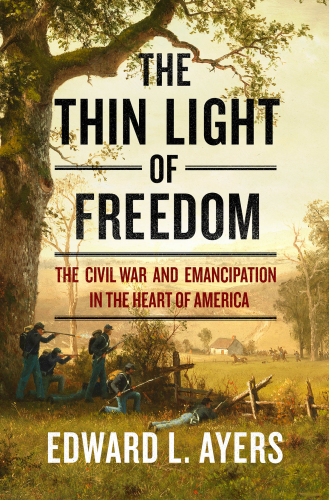
The Thin Light of Freedom
The Civil War and Emancipation in the Heart of America
کتاب های مرتبط
- اطلاعات
- نقد و بررسی
- دیدگاه کاربران
نقد و بررسی

Starred review from July 31, 2017
Ayers, president emeritus of the University of Richmond, follows his 2004 Bancroft Prize winner, In the Presence of Mine Enemies, by telling the story of the final years of the Civil War in the Great Valley between the Blue Ridge and Appalachian mountains. Both north and south of the Mason-Dixon Line, the valley was the scene of brutal fighting. Like its predecessor, this book is grounded in the experiences of combatants and civilians alike, enslaved and free, harrowed by bitter war and at the mercy of uncontrollable forces. Rather than centering the story on leading figures, politics, and military strategy, Ayers shares riveting details about average, resilient people trying to survive the devastation around them. He describes, for instance, the deadly violence perpetrated by marauding cavalry forces in the Shenandoah Valley of Virginia, and the total destruction of the northern town of Chambersburg, Pa., by fire. Readers looking for a conventional history of the Civil War or a fresh interpretation of it will find neither here. They’ll instead discover on-the-ground, local history of ravaged communities and besieged Americans struggling through a terrible war and the vexations of Reconstruction. Ayers focuses on the thoughts, fears, and hopes of normal people struggling to stay alive and make sense of the murderous events taking place around them. The result is a superb, readable work of history.

Starred review from August 15, 2017
The renowned historian of the Civil War and Reconstruction continues the story begun in his Bancroft Prize-winning In the Presence of Mine Enemies (2003), recounting those events as they played out beyond the Blue Ridge.The Civil War was fought on many fronts but perhaps none more malleable than that in the Great Valley, which runs from Pennsylvania through Maryland and into Virginia. There, writes University of Richmond president emeritus Ayers (What Caused the Civil War?: Reflections on the South and Southern History, 2005, etc.) in this luminous account, Union armies threatened the Confederacy with near impunity, while Rebel forces attempted to do the same, as at Monocacy, Chambersburg, and other northward forays. As the author chronicles, these movements were calculated as much to prolong the war in the hope of costing Abraham Lincoln the 1864 election as to achieve any lasting military victory, reason enough for Robert E. Lee to raid into Pennsylvania, thus "making Northerners feel what it meant to live in an occupied land." Along the Pennsylvania border of this heartland, communities of emancipated African-Americans, who contributed many troops to the Union cause, suffered raids that returned prisoners to slavery--even as, late in the war, Lee endorsed using black troops in the Confederate ranks. More than any other place, Ayers argues persuasively, the valley had special reason to fear the resumption of campaigning in the spring of 1864, when it "could come under assault from north and south, east and west, inside and outside." It was no less contested during Reconstruction, when voting laws were engineered to displace former rebels and impose rule by so-called carpetbaggers, an early instance of gerrymandering. As elsewhere in the South, the narrative on the war and its causes diverged from that favored in the North, building a lasting division even as the Supreme Court tolerated and even encouraged "complete legal segregation, disenfranchisement, and subjugation of black Southerners." An exemplary contribution to the history of the Civil War and its aftermath.
COPYRIGHT(2017) Kirkus Reviews, ALL RIGHTS RESERVED.

September 15, 2017
Ayers's superb new Civil War history, which began with In the Presence of Mine Enemies (2003), is set in Virginia's Great Valley and traces the stories of Augusta, VA, and Franklin, PA, counties from abolitionist John Brown's raid in 1859 to the eve of the Battle of Gettysburg in 1863. The work begins with Confederate troops invading Pennsylvania and two years of conflict, followed by the social and political chaos of Reconstruction and the passage of the 15th Amendment in 1870. Ayers notes that many Americans on both sides of the war did not anticipate the unconditional surrender of the South, the end of institutional slavery, and the reconstruction of the country based on fundamental human rights for all. Paradoxically, Ayers concludes that without secession, the mobilization of huge countervailing armies and the threat from initial military successes by the Rebels, there would likely have been no early postwar attempt at emancipation for African Americans. The author finds that "Americans made each others' history, often in ways they did not foresee or intend." VERDICT An original contribution of unimpeachable scholarship. Highly recommended for Civil War and regional historians, military theorists, and all readers.--John Carver Edwards, formerly with Univ. of Georgia Libs.
Copyright 2017 Library Journal, LLC Used with permission.

























دیدگاه کاربران